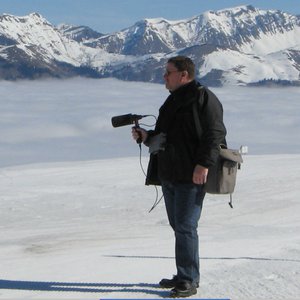Pair / Impair (1978), 11:48
stereo fixed medium
… et ainsi de suite… (1992), 19:17
stereo fixed medium
- à propos, 1:46
- (parenthèse 1), 1:00
- commentaire 1, 3:26
- (parenthèse 2), 1:27
- réflexion, 0:58
- commentaire 2, 2:45
- souffle d’insectes (parenthèse 3), 0:55
- résonance (parenthèse 4), 0:40
- résumé, 1:55
- (parenthèse 5), 0:41
- commentaire 3, 3:44
Unsound Objects (1995), 12:59
stereo fixed medium
Aria (1988), 10:54
stereo fixed medium
Hot Air (1995), 22:12
stereo fixed medium
Just over twenty years ago, after a 45-minute introduction to the studio, I set out on a journey in the electroacoustic domain. As I was about to progress to a composition doctorate, I felt that I should know something about how electroacoustic music fitted into the broader picture of composition. I soon realized that it was more a question of how instrumental composition fitted into the broader picture of working with sound!
The field of possibility in the electroacoustic medium being more or less infinite, the old certainties of the act of composition can no longer be sustained. Composing can no longer be restricted to formulating abstract relationships between material drawn from a limited array of ‘musical’ sounds via an intermediate system of graphic (visual) symbols — a formulation which is frequently more firmly rooted in notational (‘notatable’) relationships than in the perceivable relationships of sound. No, in the studio one works with sound itself and tests the results on that most fickle and yet most potent discriminatory organ of perception — the ear. Composition becomes ‘concrete’ — a collaboration between composer and the organic sound matter which (like a kind of sonic DNA) carries clues to its behaviour in various musical contexts, and to which the composer must be sensitive or risk the musical consequences of a mismatch of local and global structures. This collaborative venture involves a shift of focus away from instrumental generalizations based on an acquired cultural memory of sonic exteriors. Listening inside sounds reveals interior structures which can give rise to new, external(ized) musical forms — no longer abstract, but abstracted from the material itself. Where this initial material is drawn from recognizable sounds, the sounds of our everyday experience, then the purely musical, spectromorphological relationships between sounds are complemented by a wider frame of reference: alongside Schaeffer’s écoute réduite we can perhaps also experience ‘expanded listening.’
Little did I realize back in 1974 that my encounter with the electroacoustic medium would change my attitude to composition — and, indeed, to music itself — so fundamentally. Over this period I have travelled from formulaic throwbacks to structures built from spectromorphological connections and free associations of sound images. The pieces gathered together on this CD chart some of this journey.
Jonty Harrison, Birmingham (England, UK) [i-96]


